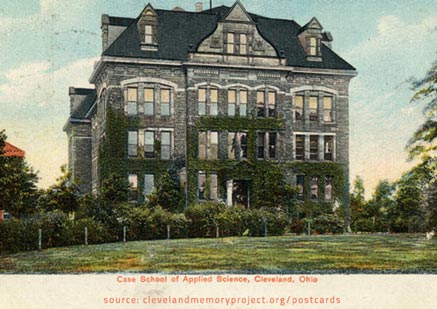

Western Reserve College was founded in 1826 in Hudson, Ohio, about 30 miles southeast of Cleveland. The college—the first in northern Ohio—took its name from the surrounding region (known at that time as the Western Reserve of Connecticut). But in 1882, with funding from American industrialist Amasa Stone, the college moved to "uptown" Cleveland, where it lives today, and assumed the name Western Reserve University.

In 1877, Leonard Case Jr., a philanthropic citizen of Cleveland and early benefactor of the engineering school, began laying the groundwork for the Case School of Applied Science. Within four months of his death in 1880, a secret trust to endow a polytechnic school in Cleveland was administered, and the Case School of Applied Science was born.
Classes initially were held in the Case family's downtown Cleveland home until a provision to Stone's gift—that Western Reserve University and the Case School of Applied Science occupy adjoining campuses—led to the school's relocation in 1885 to what is now known as University Circle on the city's east side. Funds for the land, however, had to be raised by the community.

A committee for the two institutions raised $119,400 from 56 donors by March 1881. A land purchase discount from Cordelia Ford and Liberty E. Holden, whose 43-acre property formed the early campus, netted $33,000. The Ford family's University Circle-area homesteads were the initial locations of the Women's College of Western Reserve University and the School of Law.
Over the years—especially in the post-war 1950s—the campus grew quickly, with Western Reserve University and its schools taking up residence mostly north of Euclid Avenue and Case School of Applied Science mostly south of Euclid Avenue. The campus even expanded well beyond its borders with the acquisition of Squire Valleevue Farm in Hunting Valley.
A decade-by-decade look at the changing campus is available through the university archives' website.
The two institutions agreed their 1967 federation would create a complete university worthy of national distinction, and though much of the physical campus remained unchanged by the merger, students now traversed north and south to get to class in a variety of buildings.

The 1960s saw the highest level of growth for the university—adding 13 dormitories and three commons for Western Reserve students and 15 dormitories and fraternities and two commons for Case students, plus the law school, Health Sciences Center and more.
Further growth happened across the decades, but it’s in our most recent years that campus has experienced vast changes, such as the addition of the Alumni House, the Uptown residential/retail district and the Tinkham Veale University Center, which is set to open in August 2014. All three of these projects were outlined in the university’s previous master plan as being critically important to our future.
And we’re not done yet. Construction projects underway include the new medical education building on Cleveland Clinic’s campus, the Milton and Tamar Maltz Performing Arts Center at The Temple¬–Tifereth Israel, a new think[box] innovation lab and the Wyant Athletic and Wellness Center.
We can’t wait to see what areas of growth will be outlined in the next master plan—and then to see them become realities.
Have areas that you want us to focus on? Provide your feedback now.
See upcoming meetings
< Prev Next >
Next >